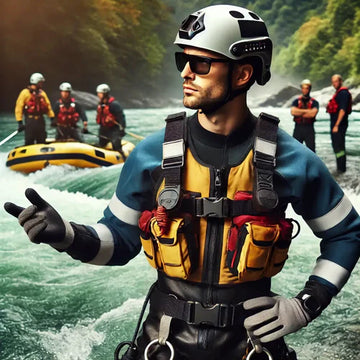Water rescue operations are some of the most dangerous and high-stakes emergency scenarios. Success depends not only on the right equipment and training but also on avoiding common mistakes that could jeopardize the safety of both rescuers and victims. In this blog, we’ll explore five things that are not allowed in water rescue and why adhering to these principles is essential.
1. Entering the Water Without Proper Equipment
One of the cardinal rules in water rescue is to never enter the water without appropriate gear. This includes:
-
Personal Flotation Devices (PFDs): Essential for buoyancy and safety.
-
Helmets: To protect against head injuries from debris or rocks.
-
Thermal Protection: Dry suits or wetsuits to prevent hypothermia.
Why It Matters: Entering the water unprepared not only endangers the rescuer but also reduces the likelihood of a successful rescue. Proper gear ensures safety and allows rescuers to operate effectively.
Solution: Always perform a gear check before engaging in any rescue operation, and ensure all team members are equipped with the necessary items.
2. Ignoring Safety Protocols
Skipping or disregarding established safety protocols can have disastrous consequences. Common violations include:
-
Entering hazardous water conditions without assessment.
-
Neglecting to secure safety lines or anchor points.
-
Operating without clear communication or coordination.
Why It Matters: Safety protocols are designed to minimize risk and maximize efficiency. Ignoring them increases the chances of injury or mission failure.
Solution: Train regularly to instill safety protocols as second nature, and assign a safety officer to oversee operations.
3. Attempting Solo Rescues
Water rescues are inherently team-based operations. Acting alone can lead to:
-
Increased risk of exhaustion or entrapment.
-
Lack of backup in case of unforeseen complications.
-
Poor situational awareness due to limited perspective.
Why It Matters: Rescuers need support to manage complex and dynamic scenarios. Operating solo reduces effectiveness and safety.
Solution: Always work in pairs or teams, with clear roles assigned to each member. Communication devices can further enhance coordination.
4. Overestimating Personal Abilities
Overconfidence can be a rescuer’s greatest downfall. This includes:
-
Underestimating the strength of currents or environmental conditions.
-
Attempting advanced techniques without sufficient training.
-
Ignoring signs of fatigue or physical limitations.
Why It Matters: Overconfidence leads to poor judgment, which can endanger both the rescuer and the victim.
Solution: Regularly assess your skills through training and always respect the power of water. Know when to call for additional help or specialized resources.
5. Failing to Assess the Scene
Rushing into a rescue without evaluating the situation is a critical error. Scene assessment should include:
-
Identifying potential hazards (e.g., debris, submerged objects, or strong currents).
-
Determining the victim’s location and condition.
-
Evaluating environmental factors like weather or tide changes.
Why It Matters: A poorly assessed scene can lead to missteps, putting everyone involved at risk.
Solution: Follow the S.T.A.R. method:
-
Stop: Pause to evaluate the situation.
-
Think: Consider the safest approach.
-
Act: Execute the rescue with a clear plan.
-
Review: Reassess conditions during the operation.
Conclusion
Water rescue is a complex and high-risk endeavor that leaves no room for mistakes. Avoiding these five common errors—entering without proper equipment, ignoring safety protocols, attempting solo rescues, overestimating abilities, and failing to assess the scene—is crucial for ensuring successful and safe outcomes.
By adhering to best practices, investing in training, and fostering teamwork, rescue teams can navigate even the most challenging scenarios with confidence and precision. Stay vigilant, stay prepared, and remember: safety always comes first.





